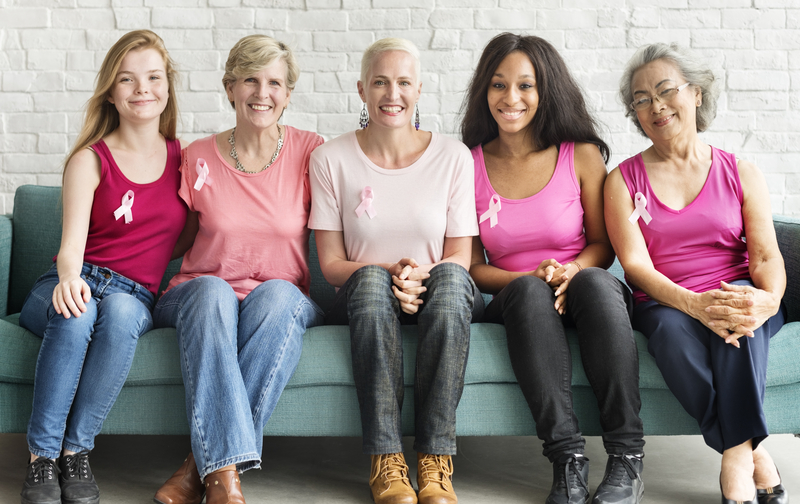Studies have shown several disparities in the way breast cancer affects Black women, as opposed to non-Black women. The question that has followed these findings is: are the disparities due to the biology and genetic makeup of different races, or due to socioeconomic factors, such as access to healthcare, education, and more? Researchers are now studying breast cancer on a molecular level to find the answer.
Breast Cancer Disparities Between Black and White Women
Research has shown that Black women have a 36% higher breast cancer mortality rate than women of other races, including white women who have a similar incidence of breast cancer as Black women.
Additional racial disparities in the occurrence of breast cancer include a younger diagnosis in Black women than in non-Black women, and double the amount of aggressive triple-negative breast cancer in Black women.
While Black women have a higher rate of getting breast cancer at a younger age, white women between the ages of 60 and 84 have a significantly higher rate of breast cancer than Black women of those ages.
Studying Breast Cancer on a Molecular Level
Peggi Angel, Ph.D., a researcher at MUSC Hollings Cancer Center, recently led a study with her graduate student Denys Rujchanarong. The pair looked at the differences in the social statuses of 30 Black women and 30 white women, and then compared them to molecular factors that could be predictive.
Through examining normal breast tissue tagged as at-risk for breast cancer, the researchers observed associations between socioeconomic stressors and specific N-glycosylation patterns in Black and white women. According to Angel, this research was the first step in “linking molecular markers to socioeconomic stress.”
The study suggests that metabolic patterns linked to socioeconomic stressors can be potential factors in the disparity of breast cancer occurrence in Black and white women.
While studying breast cancer on a molecular level is fascinating, it’s not without purpose. The goal, according to Angel, is for scientists and doctors to understand the molecular signatures of each person and ultimately develop more specific diagnoses and treatments.

Nature vs. Nurture
The question of why breast cancer appears differently in Black women as opposed to non-Black women, is similar to the age-old scientific debate: nature vs. nurture. Is it nature, i.e. the biology of Black women that makes their breast cancer mortality rate greater than non-Black women, or is it due to nurture, i.e., their background ?
Triple negative tumors are a case in point. These tumors are a particularly aggressive subtype of breast cancer, and their incidence is twice as high in Black women.
Studies have found that pregnancy can increase the risk of triple negative tumors, but breastfeeding eliminates the increased risk. Since there is a racial disparity between Black and white women breastfeeding (the former have a lower rate of breastfeeding due to cultural trauma and stigma), that can account for the higher proclivity toward triple negative tumors among Black women.
However, it’s only one factor. Other studies have shown biological differences in Black women, including plasma levels, reproductive levels, growth factors, hormones, and more. These biological differences also influence the emergence of triple negative breast cancer.
How to Reduce the Risk of Getting Breast Cancer
While scientists continue to study why racial disparities exist in breast cancer, today women know that there are certain things they can do to minimize their risk of getting the disease.
Minimizing the risk of breast cancer includes:
- Maintaining a healthy weight: Overweight and obese women are at higher risk of getting breast cancer.
- Eating healthy: Eating healthy foods like fruits and vegetables, while minimizing alcohol consumption, can minimize the risk of getting breast cancer.
- Being physically active: The Centers for Disease Control and Prevention recommends at least 150 minutes of moderate aerobic activity per week for adults.
- Taking Tamoxifen and/or Raloxifene: The FDA has approved these two prescription drugs for breast cancer prevention. While they’re not right for everyone, women should ask their doctors if these drugs are suitable for them.
- Breastfeeding (if possible): As detailed above, breastfeeding has been shown to reduce the increased risk of triple negative tumors that comes from being pregnant.
- Avoiding hormones: Birth control pills, especially when taken over the age of 35, can put women more at risk for breast cancer, as can menopausal hormone therapy.
- Not smoking: Smoking has been associated with 15 different cancers, including breast cancer. Not smoking, or quitting as soon as you can, can go a long way toward breast cancer prevention.
As scientists continue researching breast cancer, perhaps we will get a clearer idea of what’s behind racial disparities in its incidence and mortality rates. Gaining a deep understanding of how breast cancer works on a molecular level can lead to customized and more effective treatments. Women who wish to take precautions should follow the tips above. While no preventative measures are foolproof, it’s important to do as much as possible. Awareness and action go hand in hand in the fight against breast cancer.

